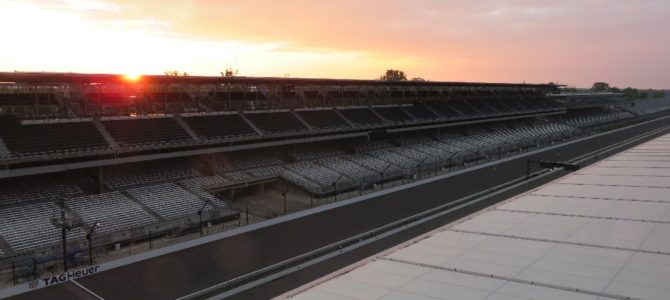
Why would hundreds of thousands of people travel for hundreds or thousands of miles to spend an afternoon sitting in the Midwestern sun—and keep doing so year after year? For those who make the pilgrimage annually, one word says it all: Indy.
Few places are more identified with a single event or image than Indianapolis with the 500-mile race that bears its name. The world’s largest single-day sporting event held in the world’s largest sporting venue draws people attracted to the spectacle, who in many cases wish to cross off a major item on their sporting event bucket list. But what keeps such a large percentage of them coming back again and again?
It is in some respects an accident of history how Indy became “Indy.” A nascent auto industry just over a century ago helped provide the environment for Carl Fisher to found the Indianapolis Motor Speedway in 1909. But that history and tradition makes the Indianapolis 500 unique.
More than a Century of Memories
Whereas stock car racing has its lure in culture—its Southern, “good-ol’ boy” roots and renegade image—Indianapolis’ draw is its history. NASCAR’s legacy dates back to moonshine runners during Prohibition, and the desire by soldiers returning from World War II to organize racing more formally. But by that time, the Indianapolis 500 had already been up and running for decades, and had its first three-time winner (Louis Meyer, who started the winners’ tradition of drinking milk in victory lane).
The Speedway’s gift shop sells a poster highlighting specific places around the 2.5-mile, 559-acre complex associated with moments in Indy 500 lore. Here’s the spot where Danny Sullivan lost control of his car, but kept it in one piece, and came back to capture the 1985 race—the “spin and win.” There’s where in 2011 J.R. Hildebrand wrecked on the last turn of the last lap, turning a certain victory into an agonizing defeat. There’s the front straightaway that saw a messy crash on the last lap of the 1967 race, where A.J. Foyt tip-toed his way through the smoke and chaos to cross the finish line for his third win: “Where’s A.J. Foyt—did he get through? There he is!”
Six years earlier, the 500’s first four-time winner had illustrated the special tradition associated with Indianapolis. The week after winning his first race in 1961, Foyt appeared on an episode of “To Tell the Truth” with Ray Harroun. It was the winner of the first Indianapolis 500 in 1911 side-by-side with the winner of the fiftieth anniversary 500. Particularly in retrospect, the episode represents a figurative passing of the torch, the first Brickyard legend (and inventor of the rear-view mirror) appearing with a giant of the Speedway’s second half-century, who remains an active owner of Indy cars.
Friends and Family Who Haven’t Yet Met
A century-plus of history gives Indianapolis an aura few places in sports can match. Even longtime drivers treat the Speedway with reverential tones, always conscious of the greats who preceded them. It’s what can make a trip to the track for last night’s Last Row Party an almost transcendent experience—the rows upon rows of grandstands beset with a tranquil calm under the Hoosier sunset, the ghosts of the Andrettis, the Unsers, and so many more echoing in the silence, the asphalt waiting to be stirred with the roar of engines three days hence.

But if the history of the venue, and the race, draws people to Indianapolis, another type of history keeps them coming back year after year. It’s the shared history that comes from bonding among friends—some close in proximity, some who only see each other once a year, re-uniting in Indiana every race weekend. It’s enjoying a mutual love of racing and speed, and the camaraderie that comes with it. Each of my trips to the 500 brings special vignettes etched in my memory—some on the track, many off. Those stories, both at the Speedway and away from it, are why people come back—sharing them, and seeking new ones as well.
Just before the command to start engines on Sunday, hundreds of thousands of spectators will join in one of the 500’s great traditions: the singing of “Back Home Again in Indiana.” For decades Jim Nabors officially performed the song, but in reality, the event generally approximates a sing-along. The hundreds of thousands of spectators that comprise this family of racing—friends and friends who haven’t yet met—sing joyfully as one, thankful for the opportunity to come together again and enjoy a uniquely American tradition. I know I sure will.
Two hundred laps around the ol’ Brickyard on a warm spring Sunday. There isn’t anything else quite like it.









